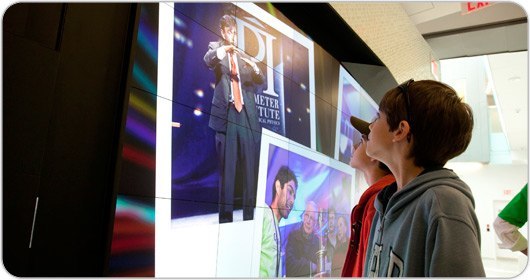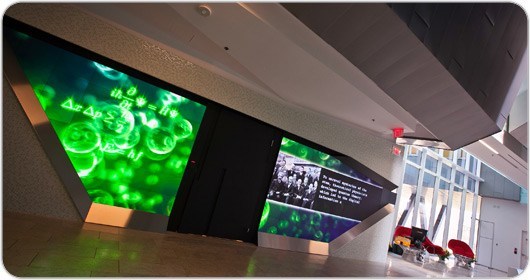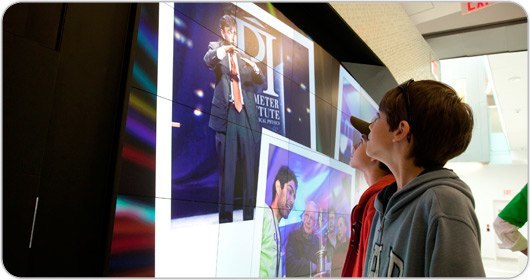
Advanced Physics Institute Lights Up Crazy Hexagonal MicroTiles Wall
February 13, 2012 by Dave Haynes
One of the big value propositions around the display tiles like those done by Christie and Prysm is the whole idea of introducing new shapes to a video wall business that has long been about squares and rectangles. A new installation at a research institute named after Stephen Hawking certainly takes shape in a new direction.
The Stephen Hawking Centre at the Perimeter Institute for Theoretical Physics in Waterloo, Ont. now has a wall of 84 Christie MicroTiles in some sort of crazy hexagon, greeting people as they enter the building. Sparks start shooting out of my ears when I try to understand what they do at this place (sample: a talk tomorrow on “a proposed dual matrix formulation of N = 4 Super Yang-Mills on R^4 coupled to 4D Einstein supergravity”).
Nonetheless, the institute an hour or so south of Toronto describes itself as a “basic research centre dedicated to exploring the world around us at its most fundamental level.” It was founded and bankrolled by Research In Motion (BlackBerry) money, going back to 1999.
Says a release:
“The video wall’s shape is arranged in a ‘V’ with a narrow base of three MicroTiles wide and works its way up to eight wide at the top of the array,” said Randy Pagnan, President, RP Visual Solutions (RPV). “Any MicroTiles array greater than five tiles high benefit greatly from a consolidated back frame, which is what RPV constructed; our adjustability and capability to align each MicroTile guarantees the tight seams of the video wall. MicroTiles allow the flexibility to provide that ‘architectural’ look Perimeter was seeking to achieve.”
The scale, diversity, and modular design of Christie MicroTiles in architectural spaces allow a building’s design and the organization occupying it to ‘speak’ with the Christie MicroTiles as the creative medium.
“The wall’s design is a fusion of messaging, mission and architecture – and it all came together because of the Christie MicroTiles technology,” said John Matlock, Director of External Relations and Public Affairs at Perimeter Institute. “The flexibility of MicroTiles allowed for the whole space to come together in a very exciting way. The unique shape of the media wall – including a functioning passageway – is in line with the architect’s vision of the main entrance to Perimeter Institute.”
Matlock explained that Perimeter’s small in-house graphics and audiovisual team needed a visual display technology that would enable them to manipulate and update zones, backgrounds and the overall display with ease. With the use of vibrant color, the MicroTiles’ digital canvas enables the Institute’s graphic artist to create, import, and display high-resolution and highly detailed scientific animations to help share abstract concepts in theoretical physics. In addition, the MicroTiles display will share daily news about the many research, training and outreach activities taking place throughout the facility.
“In the past we had plasma displays to impart basic information – times, dates, names. However, in expanding the research center, the Christie MicroTiles’ high-resolution capabilities, color and clarity really took us to that next level where we could bring information to life in all new ways, including the display of highly detailed scientific images and computer-generated animations,” Matlock continued.
“Many different communities – researchers, trainees, students, teachers, members of the public and even our many stakeholders – pass by and speak in overwhelmingly positive tones about the media wall. The Christie MicroTiles provide a ‘wow’ factor when we share information about Perimeter’s purposes and other messaging. I think we are in an ideal position with Christie MicroTiles to keep the communications as fresh, impactful and awe-inspiring as the Stephen Hawking Centre itself.”
“Christie MicroTiles allow for the creativity of architects to realize their vision and do things they couldn’t do only a few years ago,” Pagnan concluded.





Great article. It is indeed a fabulous installation (I admit to a slight bias). Only one minor nit to pick: “an hour or so south of Toronto” means a long, wet, drive under Lake Ontario! I think you meant west 🙂
South and west then … pfffft